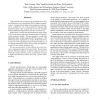Free Online Productivity Tools
i2Speak
i2Symbol
i2OCR
iTex2Img
iWeb2Print
iWeb2Shot
i2Type
iPdf2Split
iPdf2Merge
i2Bopomofo
i2Arabic
i2Style
i2Image
i2PDF
iLatex2Rtf
Sci2ools
HPCA
2001
IEEE
2001
IEEE
Differential FCM: Increasing Value Prediction Accuracy by Improving Table Usage Efficiency
Value prediction is a relatively new technique to increase the Instruction Level Parallelism (ILP) in future microprocessors. An important problem when designing a value predictor is efficiency: an accurate predictor requires huge prediction tables. This is especially the case for the finite context method (FCM) predictor, the most accurate one. In this paper, we show that the prediction accuracy of the FCM can be greatly improved by making the FCM predict strides instead of values. This new predictor is called the differential finite context method (DFCM) predictor. The DFCM predictor outperforms a similar FCM predictor by as much as 33%, depending on the prediction table size. If we take the additional storage into account, the difference is still 15% for realistic predictor sizes. We use several metrics to show that the key to this success is reduced aliasing in the level-2 table. We also show that the DFCM is superior to hybrid predictors based on FCM and stride predictors, since ...
Accurate Predictor | Computer Architecture | HPCA 2001 | Realistic Predictor Sizes | Similar Fcm Predictor |
| Added | 01 Dec 2009 |
| Updated | 01 Dec 2009 |
| Type | Conference |
| Year | 2001 |
| Where | HPCA |
| Authors | Bart Goeman, Hans Vandierendonck, Koenraad De Bosschere |
Comments (0)

